The Taj Mahal incorporates and expands on design traditions of Persianand earlier Mughal architecture. Specific inspiration came from successful Timurid and Mughal buildings including; the Gur-e Amir (the tomb of Timur, progenitor of the Mughal dynasty, in Samarkand),[7] Humayun's Tomb, Itmad-Ud-Daulah's Tomb(sometimes called the Baby Taj), and Shah Jahan's own Jama Masjid inDelhi. While earlier Mughal buildings were primarily constructed of redsandstone, Shah Jahan promoted the use of white marble inlaid with semi-precious stones. Buildings under his patronage reached new levels of refinement.[8]
"Shah jahan on a globe" from theSmithsonian Institution
Artistic depiction of Mumtaz Mahal
Tomb
The tomb is the central focus of the entire complex of the Taj Mahal. It is a large, white marble structure standing on a square plinth and consists of a symmetrical building with an iwan (an arch-shaped doorway) topped by a large dome and finial. Like most Mughal tombs, the basic elements are Persian in origin.[9]
The base structure is a large multi-chambered cube with chamferedcorners forming an unequal eight-sided structure that is approximately 55 metres (180 ft) on each of the four long sides. Each side of the iwan is framed with a huge pishtaq or vaulted archway with two similarly shaped arched balconies stacked on either side. This motif of stacked pishtaqs is replicated on the chamfered corner areas, making the design completely symmetrical on all sides of the building. Four minarets frame the tomb, one at each corner of the plinth facing the chamfered corners. The main chamber houses the falsesarcophagi of Mumtaz Mahal and Shah Jahan; the actual graves are at a lower level.[10]
The most spectacular feature is the marble dome that surmounts the tomb. The dome is nearly 35 metres (115 ft) high which is close in measurement to the length of the base, and accentuated by the cylindrical "drum" it sits on which is approximately 7 metres (23 ft) high. Because of its shape, the dome is often called an onion dome or amrud (guava dome).[11] The top is decorated with alotus design which also serves to accentuate its height. The shape of the dome is emphasized by four smaller domed chattris (kiosks) placed at its corners, which replicate the onion shape of the main dome. Their columned bases open through the roof of the tomb and provide light to the interior. Tall decorative spires (guldastas) extend from edges of base walls, and provide visual emphasis to the height of the dome. The lotus motif is repeated on both the chattris andguldastas. The dome and chattris are topped by a gilded finial which mixes traditional Persian and Hindustani decorative elements.
The main finial was originally made of gold but was replaced by a copy made of gilded bronze in the early 19th century. This feature provides a clear example of integration of traditional Persian and Hindu decorative elements. The finial is topped by a moon, a typical Islamic motif whose horns pointheavenward.[12]
The minarets, which are each more than 40 metres (130 ft) tall, display the designer's penchant for symmetry. They were designed as working minarets—a traditional element of mosques, used by the muezzin to call the Islamic faithful to prayer. Each minaret is effectively divided into three equal parts by two working balconies that ring the tower. At the top of the tower is a final balcony surmounted by a chattri that mirrors the design of those on the tomb. The chattris all share the same decorative elements of a lotus design topped by a gilded finial. The minarets were constructed slightly outside of the plinth so that in the event of collapse, a typical occurrence with many tall constructions of the period, the material from the towers would tend to fall away from the tomb.
Exterior decorations
The exterior decorations of the Taj Mahal are among the finest in Mughal architecture. As the surface area changes, the decorations are refined proportionally. The decorative elements were created by applying paint, stucco, stone inlays or carvings. In line with the Islamic prohibition against the use of anthropomorphic forms, the decorative elements can be grouped into eithercalligraphy, abstract forms or vegetative motifs. Throughout the complex arepassages from the Qur'an that comprise some of the decorative elements. Recent scholarship suggests that the passages were chosen by Amanat Khan.[13][14]
The calligraphy on the Great Gate reads"O Soul, thou art at rest. Return to the Lord at peace with Him, and He at peace with you."[14] The calligraphy was created in 1609 by a calligrapher named Abdul Haq. Shah Jahan conferred the title of "Amanat Khan" upon him as a reward for his "dazzling virtuosity".[15] Near the lines from the Qur'an at the base of the interior dome is the inscription, "Written by the insignificant being, Amanat Khan Shirazi."[16] Much of the calligraphy is composed of florid thuluth script made of jasper or black marble[15] inlaid in white marble panels. Higher panels are written in slightly larger script to reduce the skewing effect when viewed from below. The calligraphy found on the marble cenotaphs in the tomb is particularly detailed and delicate.
Abstract forms are used throughout, especially in the plinth, minarets, gateway, mosque, jawab and, to a lesser extent, on the surfaces of the tomb. The domes and vaults of the sandstone buildings are worked with tracery ofincised painting to create elaborate geometric forms. Herringbone inlays define the space between many of the adjoining elements. White inlays are used in sandstone buildings, and dark or black inlays on the white marbles. Mortared areas of the marble buildings have been stained or painted in a contrasting color which creates a complex array of geometric patterns. Floors and walkways use contrastingtiles or blocks in tessellation patterns.
On the lower walls of the tomb are white marble dados sculpted with realisticbas relief depictions of flowers and vines. The marble has been polished to emphasise the exquisite detailing of the carvings. The dado frames and archwayspandrels have been decorated withpietra dura inlays of highly stylised, almost geometric vines, flowers and fruits. The inlay stones are of yellow marble, jasper and jade, polished and levelled to the surface of the walls.[15]
Interior decoration
The interior chamber of the Taj Mahal reaches far beyond traditional decorative elements. The inlay work is not pietra dura, but a lapidary of precious and semipreciousgemstones.[17] The inner chamber is an octagon with the design allowing for entry from each face, although only the door facing the garden to the south is used. The interior walls are about 25 metres (82 ft) high and are topped by a "false" interior dome decorated with a sun motif. Eight pishtaq arches define the space at ground level and, as with the exterior, each lower pishtaq is crowned by a second pishtaq about midway up the wall.[18] The four central upper arches form balconies or viewing areas, and each balcony's exterior window has an intricate screen or jalicut from marble. In addition to the light from the balcony screens, light enters through roof openings covered by chattris at the corners. The octagonal marble screen or jali bordering the cenotaphs is made from eight marble panels carved through with intricate pierce work. The remaining surfaces are inlaid in delicate detail with semi-precious stones forming twining vines, fruits and flowers. Each chamber wall is highly decorated with dado bas-relief, intricate lapidary inlay and refined calligraphy panels which reflect, in miniature detail, the design elements seen throughout the exterior of the complex.[19]
Muslim tradition forbids elaborate decoration of graves. Hence, the bodies of Mumtaz and Shah Jahan were put in a relatively plain crypt beneath the inner chamber with their faces turned right, towards Mecca. Mumtaz Mahal'scenotaph is placed at the precise centre of the inner chamber on a rectangular marble base of 1.5 by 2.5 metres (4 ft 11 in by 8 ft 2 in). Both the base andcasket are elaborately inlaid with precious and semiprecious gems. Calligraphic inscriptions on the casket identify and praise Mumtaz. On the lid of the casket is a raised rectangular lozenge meant to suggest a writing tablet. Shah Jahan's cenotaph is beside Mumtaz's to the western side, and is the only visible asymmetric element in the entire complex. His cenotaph is bigger than his wife's, but reflects the same elements: a larger casket on a slightly taller base precisely decorated with lapidary and calligraphy that identifies him. On the lid of the casket is a traditional sculpture of a small pen box.[18]
The pen box and writing tablet are traditional Mughal funerary icons decorating the caskets of men and women respectively. The Ninety Nine Names of God are calligraphic inscriptions on the sides of the actual tomb of Mumtaz Mahal. Other inscriptions inside the crypt include, "O Noble, O Magnificent, O Majestic, O Unique, O Eternal, O Glorious... ". The tomb of Shah Jahan bears a calligraphic inscription that reads; "He travelled from this world to the banquet-hall of Eternity on the night of the twenty-sixth of the month of Rajab, in the year 1076 Hijri."[20]
Garden
The complex is set around a large 300-metre (980 ft) square charbagh orMughal garden. The garden uses raised pathways that divide each of the four quarters of the garden into 16 sunkenparterres or flowerbeds. Halfway between the tomb and gateway in the center of the garden is a raised marble water tank with a reflecting poolpositioned on a north-south axis to reflect the image of the mausoleum. The raised marble water tank is called al Hawd al-Kawthar in reference to the "Tank of Abundance" promised toMuhammad.[21]
Elsewhere, the garden is laid out with avenues of trees and fountains. Thecharbagh garden, a design inspired byPersian gardens, was introduced to India by Babur, the first Mughal emperor. It symbolises the four flowing rivers of Jannah (Paradise) and reflects the Paradise garden derived from the Persian paridaeza, meaning 'walled garden'. In mystic Islamic texts of the Mughal period, Paradise is described as an ideal garden of abundance with four rivers flowing from a central spring or mountain, separating the garden into north, west, south and east.
Most Mughal charbaghs are rectangular with a tomb or pavilion in the center. The Taj Mahal garden is unusual in that the main element, the tomb, is located at the end of the garden. With the discovery of Mahtab Bagh or "Moonlight Garden" on the other side of the Yamuna, the interpretation of theArchaeological Survey of India is that the Yamuna river itself was incorporated into the garden's design and was meant to be seen as one of the rivers of Paradise.[22] Similarities in layout and architectural features withthe Shalimar Gardens suggests both gardens may have been designed by the same architect, Ali Mardan.[23] Early accounts of the garden describe its profusion of vegetation, including abundant roses, daffodils, and fruit trees.[24] As the Mughal Empire declined, the Taj Mahal and its gardens also declined. By the end of the 19th century, the British Empire controlled more than three-fifths of India,[25] and assumed management of the Taj Mahal. They changed the landscaping to their liking which more closely resembled the formal lawns of London.[26]
Outlying buildings
The Taj Mahal complex is bordered on three sides by crenellated red sandstone walls; the side facing the river is open. Outside the walls are several additional mausoleums, including those of Shah Jahan's otherwives, and a larger tomb for Mumtaz's favourite servant.[27]
The main gateway (darwaza) is a monumental structure built primarily of marble, and reminiscent of the Mughal architecture of earlier emperors. Its archways mirror the shape of the tomb's archways, and its pishtaq arches incorporate the calligraphy that decorates the tomb. The vaulted ceilings and walls have elaborate geometric designs like those found in the other sandstone buildings in the complex.[28]
At the far end of the complex are two grand red sandstone buildings that mirror each other, and face the sides of the tomb. The backs of the buildings parallel the western and eastern walls. The western building is a mosque and the other is the jawab (answer), thought to have been constructed for architectural balance although it may have been used as a guesthouse. Distinctions between the two buildings include the jawab's lack of a mihrab (a niche in a mosque's wall facing Mecca), and its floors of geometric design whereas the floor of the mosque is laid with outlines of 569 prayer rugs in black marble. The mosque's basic design of a long hall surmounted by three domes is similar to others built by Shah Jahan, particularly the Masjid-i Jahān-Numā, orJama Masjid, Delhi. The Mughal mosques of this period divide thesanctuary hall into three areas comprising a main sanctuary and slightly smaller sanctuaries on either side. At the Taj Mahal, each sanctuary opens onto an expansive vaulting dome. The outlying buildings were completed in 1643.[29]





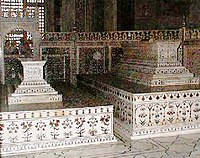





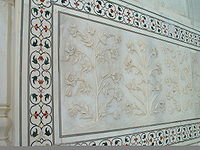
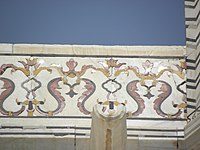



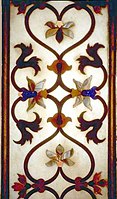
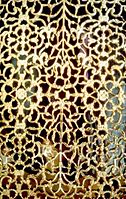



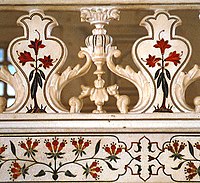

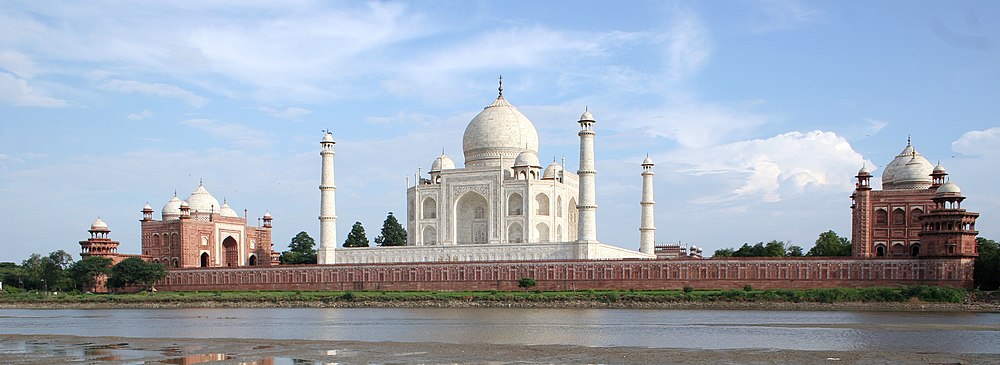
No comments:
Post a Comment